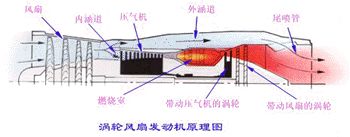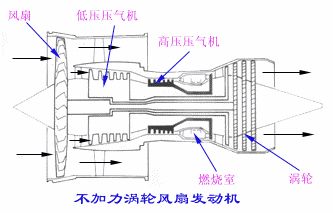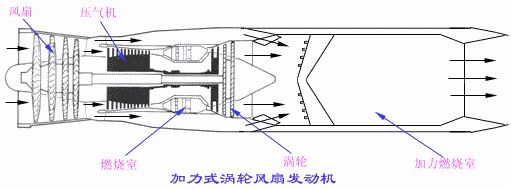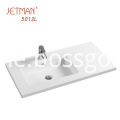Since Whittle invented the first turbojet engine, the turbojet engine quickly replaced the piston engine with its powerful power and excellent high-speed performance, becoming the preferred powerplant for fighters and began to start in other aircraft. Get the app.

However, with the development of jet technology, the shortcomings of turbojet engines are becoming more and more prominent, that is, the fuel consumption is low and the efficiency is low at low speed, which makes the flight of the aircraft very short. Although this is not very serious for high-speed fighters performing air defense missions, it is unacceptable if it is used on subsonic civil transport aircraft that have strict economic requirements.
To improve the efficiency of a jet engine, you must first know what type of engine is efficient. The efficiency of the engine actually consists of two parts, namely thermal efficiency and propulsion efficiency. In order to improve the thermal efficiency, it is generally necessary to increase the temperature of the gas before the turbine and the pressure ratio of the compressor, but if the flight speed of the aircraft is constant, increasing the temperature before the turbine will increase the exhaust speed of the jet engine. This results in an increase in kinetic energy lost in the air, which in turn reduces propulsion efficiency. Due to the contradiction between the thermal efficiency and the propulsion efficiency on the engine cycle parameters, the total efficiency of the turbojet engine is difficult to be greatly improved.

So, how can we simultaneously improve the thermal efficiency and propulsion efficiency of a jet engine, that is, how can we increase the temperature before the turbine and at least increase the exhaust speed? The answer is to use a turbofan engine. This type of engine adds several stages of turbines to the turbojet engine, and these turbines drive one or several rows of fans. The airflow behind the fan is divided into two parts, one part enters the compressor (connotation channel), and the other part does not. After burning, it is discharged directly into the air (outer duct). Since part of the gas energy of the turbofan engine is used to drive the fan at the front end, the exhaust speed is reduced, the propulsion efficiency is improved, and if the pre-turbine temperature is increased to improve the thermal efficiency, the turbine structure parameters can be adjusted and increased. The fan diameter allows more gas energy to be transferred to the outer duct via the fan without increasing the exhaust speed. Thus, for turbofan engines, thermal efficiency and propulsion efficiency are no longer contradictory, and as long as the structure and materials allow, it is always advantageous to increase the pre-turbine temperature.
At present, the aviation turbofan engines are mainly divided into two types, namely, a non-energized turbofan engine and an afterburning turbofan engine. The former is mainly used for high-sonic conveyors, and the latter is mainly used for fighters. Due to different uses, the structural parameters of these two types of engines are also very different.

The non-energized turbofan engine not only has a higher temperature in front of the turbine, but also has a larger fan diameter and a bypass ratio of more than 8. This engine is more economical than a turbojet engine, and the available flight speed is higher than that of a piston engine. It is widely used in aircraft with a maximum speed of M0.9, such as modern large-scale passenger aircraft and military transport aircraft. According to the principle of the heat engine, when the power of the engine is constant, the more the working medium that participates in the propulsion, the greater the thrust obtained. The non-energized turbofan engine has a large fan diameter, the air flow is large, and the thrust is also large. . At the same time, due to the low exhaust speed, the noise of this engine is also small.
The afterburning turbofan engine does not work in the cruising of the aircraft. At this time, it is equivalent to a non-energized turbofan engine, but in order to pursue a high thrust-to-weight ratio and reduce the resistance, the engine is ducted. The ratio is generally below 1.0. During high-speed flight, the engine's afterburner is opened, and the air in the outer duct and the gas after the turbine enter the afterburner to inject the fuel and burn again, so that the thrust can be greatly increased, even exceeding the afterburning turbojet. And as the speed increases, the engine's afterburner ratio will rise and the fuel consumption rate will decrease. The afterburning turbofan engine has the characteristics of low fuel consumption at this low speed and large thrust-to-weight ratio when the force is applied. It has been widely used in the new generation of fighters.
What make ceramic mid-edge hand wash basins different from thin-edge Basin is the thickness as 35mm. Good flatness with shining glaze also make mid-edge basins enjoy good-reputation in our oversea markets. More style and design, thanks to check in the products` details.
GUANGDONG ZHIJIE (JETMAN as brand name) SANITARY WARE CO., LTD. is located in Chaozhou city, ceramic capital of China. Established in 1999, JETMAN has grown to be a large-scale enterprise specializing in producing ceramic basins.
Equipped with most advanced casting equipment and computerized kiln, Jetman is able to meet daily capacity of 3,000pcs. By installing most advanced production equipment, JETMAN has introduced more than 300 designs into its range, including Thin-edge basin, Mid-edge basin, Cabinet Basin, laundry basin, Art Basin, Counter basin and Color Basin. Thanks to its own R&D department, Jetman has an edge over others in developing exclusive designs upon customer drawings. Options of purchasing either AB grade or A grade are available.
810*460*150 Japanese glaze available mid edge basin
Sanitary Imported Wash Basin,Ceramic Bathroom Sinks Kitchen Porcelain,Ceramic Rectangle Hand Wash Basin,Western Bathroom Sink
GUANGDONG ZHIJIE SANITARY WARE CO., LTD. , https://www.zhijiesanitary.com